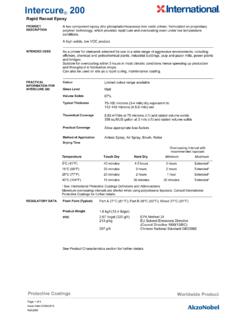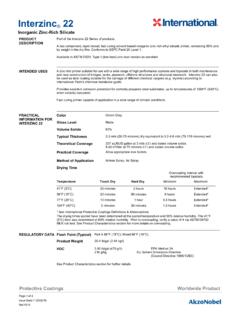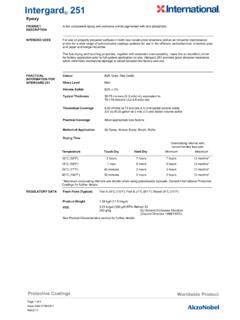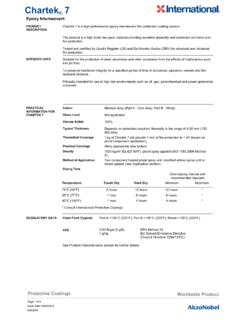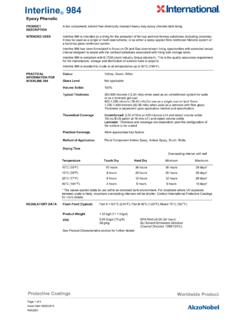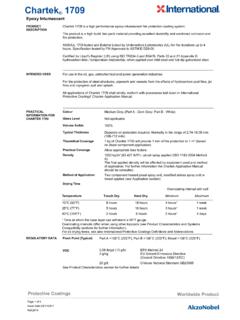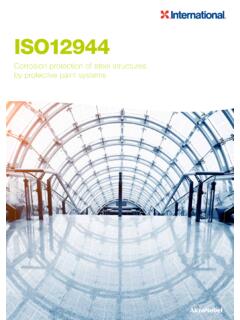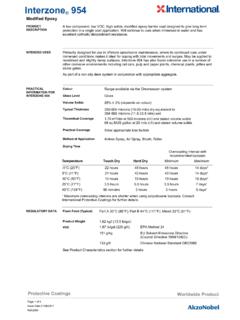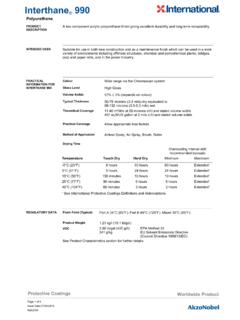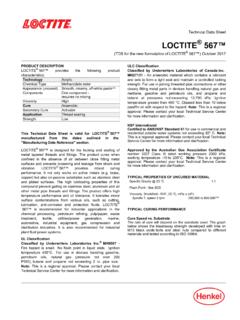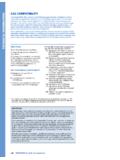Transcription of Intercure 200HS - AkzoNobel
1 A two component, high solids, low VOC, epoxy zinc phosphate/micaceous iron oxide primer offering excellent barrier protection, low temperature cure and rapid overcoating properties. product DESCRIPTIONAs a primer for steelwork intended for use in a wide range of environmental conditions including offshore, chemical and petrochemical plants, industrial buildings, pulp and paper mills, power plants and bridges. Suitable for overcoating within 7 hours in most climatic conditions hence speeding up production and throughput in fabrication shops. Provides quick cure even at low temperatures often encountered in maintenance painting.
2 INTENDED USESSand, Grey, Red Matt 80%150-200 microns (6-8 mils) dry equivalent to188-250 microns ( mils) wet m /litre at 150 microns and stated volume solids214 gallon at 6 mils and stated volume solids Allow appropriate loss factors Airless Spray, Air Spray, Brush, Roller PRACTICAL INFORMATION FOR Intercure 200 HSColourGloss LevelVolume SolidsTypical ThicknessTheoretical CoveragePractical CoverageMethod of ApplicationDrying TimeTemperature Touch DryHard DryMinimumMaximum See International Protective Coatings Definitions and AbbreviationsOvercoating Interval withrecommended topcoats5 C (41 F) 4 hours10 hours7 hours Extended 15 C (59 F) 3 hours6 hours4 hours Extended 25 C (77 F)
3 2 hours3 hours3 hours Extended 40 C (104 F) 30 minutes1 hour1 hour Extended Part A 38 C (100 F); Part B 27 C (81 F); Mixed 33 C (91 F) kg/l ( lb/gal) REGULATORY DATAF lash Point (Typical) product WeightVOCSee product Characteristics section for further details lb/gal (230 g/lt) EPA Method 24139 g/kg EU Solvent Emissions Directive(Council Directive 1999/13/EC)187 g/lt Chinese National Standard GB23985 Intercure 200 HSRapid Recoat EpoxyPage 1 of 4 Ref:2087 Issue Date:22/09/2015 Protective CoatingsWorldwide ProductIntercure 200 HSRapid Recoat EpoxyAll surfaces to be coated should be clean, dry and free from contamination.
4 Prior to paint application all surfaces should be assessed and treated in accordance with ISO 8504:2000. Oil or grease should be removed in accordance with SSPC-SP1 solvent cleaning. Abrasive Blast CleaningAbrasive blast clean to Sa2 (ISO 8501-1:2007) or SSPC-SP6. If oxidation has occurred between blasting and application of Intercure 200HS , the surface should be reblasted to the specified visual standard. Surface defects revealed by the blast cleaning process should be ground, filled, or treated in the appropriate manner. Intercure 200HS is suitable for application to blast cleaned surfaces which were initially to the above standard but have been allowed to deteriorate under good shop conditions for up to 7-10 days.
5 The surface may deteriorate to Sa2 standard but must be free from loose powdery deposits. A sharp, angular profile of 50-75 m (2-3 mils) should be achieved. Shop Primed SteelWeld seams and damaged areas should be blast cleaned to Sa2 (ISO 8501-1:2007) or SSPC-SP6. If the shop primer shows extensive or widely scattered breakdown overall sweep blasting may be PREPARATIONM aterial is supplied in two containers as a unit. Always mix a complete unit in the proportions supplied. Once the unit has been mixed it must be used within the working pot life specified.(1) Agitate Base (Part A) with a power agitator.
6 (2) Combine entire contents of Curing Agent (Part B) with Base(Part A) and mix thoroughly with power agitator. 3 part(s) : 1 part(s) by volume Suitable - small areas onlyTypically 75 microns ( mils) can be achievedSuitable - small areas onlyTypically 75 microns ( mils) can be achieved International GTA220 International GTA220 (or GTA415) Do not allow material to remain in hoses, gun or spray equipment. Thoroughly flush all equipment with International GTA220. Once units of paint have been mixed they should not be resealed and it is advised that after prolonged stoppages work recommences with freshly mixed units.
7 Clean all equipment immediately after use with International GTA220. It is good working practice to periodically flush out spray equipment during the course of the working day. Frequency of cleaning will depend upon amount sprayed, temperature and elapsed time, including any delays. All surplus materials and empty containers should be disposed of in accordance with appropriate regional regulations/legislation. Thinning is not normally required. Consult the local representative for advice during application in extreme conditions. Do not thin more than allowed by local environmental legislation.
8 RecommendedRecommended(5% thinning required)Gun DeVilbiss MBC or JGAAir Cap 704 or 765 Fluid Tip E Tip Range mm (18-23 thou)Total output fluid pressure at spray tip not less than 170 kg/cm (2417 )APPLICATIONM ixingMix RatioWorking Pot LifeAirless SprayAir Spray(Pressure Pot)BrushRollerThinnerCleanerWork StoppagesClean Up5 C (41 F) 15 C (59 F) 25 C (77 F) 40 C (104 F) 150 minutes90 minutes1 hour20 minutesPage 2 of 4 Intercure 200 HSRapid Recoat EpoxyIntercure 200HS is preferred for use with systems for chemical environments where zinc based materials can be subject to attack in both acidic and alkaline conditions.
9 Over-application should be avoided as thick films will not be as good a substrate for topcoat adhesion after ageing as those at the specified thickness. Surface temperature must always be a minimum of 3 C above dew point. This product must only be thinned using recommended International GTA220 thinners. The use of alternative thinners, particularly those containing ketones, can severely inhibit the curing mechanism of the coating. At low temperatures, it may be necessary to thin Intercure 200HS to enable airless spray application to be performed. Normally 2% thinning (by volume) with International GTA220 will be satisfactory for this purpose.
10 Intercure 200HS is capable of curing at temperatures below 0 C (32 F). However, this product should not be applied at temperatures below 0 C (32 F) where there is a possibility of ice formation on the substrate. This product is not available in pale and pastel shades due to a tendency to discolour rapidly. Additionally, in common with all epoxies Intercure 200HS will chalk on exterior exposure. However, these phenomena are not detrimental to anti-corrosive performance. Intercure 200HS is not intended for use as a primer for steelwork which may be subjected to continuous immersion conditions.
